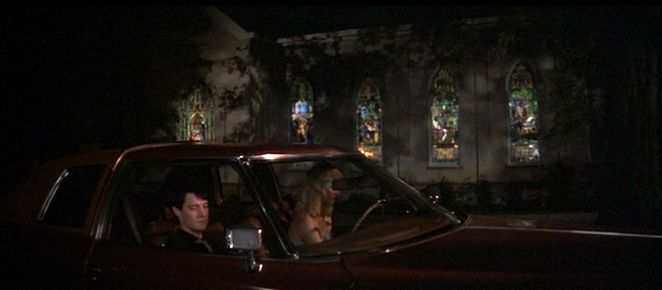 Back to selection
Back to selection
The Blue Velvet Project
Blue Velvet, 47 seconds at a time by Nicholas Rombes
The Blue Velvet Project, #73

Second #3431, 57:11
Outside of church (St. Paul’s Evangelical Lutheran Church, in Wilmington, North Carolina), Jeffrey and Sandy prepare to leave. The scene in question is a fulcrum point in postmodern cinema: are Jeffrey’s lament about the presence of evil in the world, Sandy’s monologue about the robins bringing light, and the church itself, shaded with sincerity or irony? For many contemporary reviewers, the “hokey,” melodramatic acting was the sign of a cold tactician at work. In his Washington Post review, Paul Attanasio wrote that “Lynch likes to use wooden acting as a distancing technique, or a kind of joke.”
Perhaps Blue Velvet is an uncomfortable film to watch not because of its depictions of violence, but because it asks us to hold our in our gaze for long periods of time characters’ faces as they work through moral tangles that they happen to view in terms of good and evil, right and wrong. What happens in Blue Velvet is precisely the opposite of that Attanasio called a distancing technique; if anything, the film brings audiences very, very close to its characters. The initial uncertainty about Blue Velvet’s tone probably has a lot to do with the 1980s itself, which modulated between the flat, affectless responses to depravity in novels like Bret Easton Ellis’s Less Than Zero (1985) and the moral severity of the Reagan era. (Reagan had referred to the Soviet Union as “the evil empire” in a 1983 speech, a speech which also contains a serious contemplation of the place of people like Frank in the world. How many presidents have ever used the word “phenomenology” before? “We know that living in this world means dealing with what philosophers would call the phenomenology of evil or, as theologians would put it, the doctrine of sin.”)
But there is the undeniable fact of beauty in the world, too, Blue Velvet whispers to us. The beauty of the outside of that church at second #3431, the tree shadows on its walls and the way the windows hold colors in their secret-code shapes, and the bare skin of Sandy’s arm (her eyes temporarily black-barred out by the rearview mirror) and the light on Jeffrey’s face. It’s as if the film had become scrambled in time, fractured in such a way that in the thinnest of gaps between its frames another face, another song, in grainy black and white, hides there, waiting to be activated from future-hibernation. When does it happen? When do you realize that you’ve fallen so deeply, so deeply into something that even the sky at its widest is not wide enough? Is it around the 1:35 mark, below, when Julianna Barwick (thank you, Believer) lowers her voice and opens her eyes, as if she suddenly recognizes a dark, dark thought?
Over the period of one full year — three days per week — The Blue Velvet Project will seize a frame every 47 seconds of David Lynch’s classic to explore. These posts will run until second 7,200 in August 2012. For a complete archive of the project, click here. And here is the introduction to the project.
